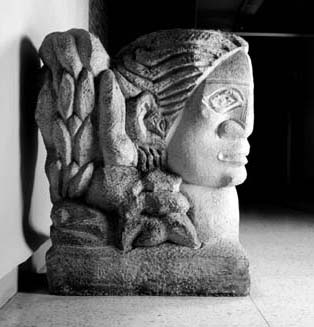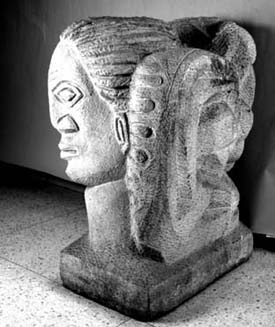

Eva Perón,
arquetipo símbolo. 1952
Piedra de Gard
Stone of Gard. h: 1.12 mts.
Collection Universidad Torcuato Di Tella
La polémica sobre la obra
Arquetipo Símbolo
Un gran escultor argentino, el necesario rescate de
Sesostris Vitullo
por Orlando Barone
Este artículo es un fragmento del publicado en la
Revista Crisis, nº2, Buenos Aires, Junio de 1973.
The polemic on the work
"Arquetipo Símbolo"
(Archetype Symbol)
A great Argentinean sculptor,
Sesostris Vitullo's necessary rescue
by Orlando Barone
This article is a fragment of the one published in Crisis
Magazine, nº2, Buenos Aires, June 1973.
En 1950 Salvador María del Carril, por entonces
encargado de negocios de la Argentina en Francia,
consultó con Ignacio Pirovano la Posibilidad de
encargarle a Sesostris Vitullo un monumento a Eva
Perón. Según el consejo de Pirovano no
había argentino más capaz para la tarea.
Al recibir el pedido Vitullo comprendió que no
podía afrontar el trabajo sin conocer algo más
a Eva Perón. Le pidió, pues, a su amigo
Pirovano que le informe sobre Evita. Luego de cambiar varias
cartas Vitullo creyó conocer lo necesario para
intentar la obra.
"He comprendido todo. Eva Perón Arquetipo
Símbolo. Libertadora de las razas oprimidas de
América. La veo como un mascarón de proa
rodeada de laureles." Este párrafo de una carta que
Vitullo envió a Pirovano sintetiza lo que
habría de ser su criterio frente al monumento.
La obra fue terminada en 1952. Es piedra, dos caras rodeadas
de laureles: un perfil es de Evita y el otro un perfil casi
Indio. No hay regodeos, ni complacencias, ni demagogias. El
artista resume en esos trazos severos y bellísimos lo
que había comprendido sobre Eva Perón y por
eso su obra se llama Arquetipo símbolo.
En ese año de 1952 Vitullo obtuvo un triunfo que solo
consiguieron muy pocos artistas del mundo: una
exposición de sus obras en el Museo de Arte Moderno
de París, en vida. En el catálogo figura
Arquetipo símbolo. Antes de llevarlo a la sala de
exposición donde habría de exhibirse al
público francés, el artista quiso hacer
conocer su trabajo en la embajada argentina que auspiciaba
la muestra. Personalmente eligió el lugar para que
instalaran el monumento a Evita, controló la luz,
revisó los detalles. Su última obra.
Las autoridades diplomáticas ven el monumento, no hay
comentarios. Una extraña frialdad sorprende al
artista. Pocos días después la piedra es
retirada del lugar elegido por Vitullo. Antes de que se
inaugure la exposición en el museo es trasladada a un
sótano.
La exposición se clausuró sin que Vitullo
consi-guiera que la embajada remita al Museo el trabajo
titulado Arquetipo símbolo. Nunca lo recuperó.
Sesostris Vitullo murió en mayo de 1953.
In 1950 Salvador María del
Carril, then in charge of Argentina's businesses in France,
consulted with Ignacio Pirovano the possibility of asking
Sesostris Vitullo to sculpt a monument to Eva Perón.
According to Pirovano's advice, there was not a most
suitable Argentinean for the task.
When receiving the request, Vitullo understood he could not
face the work without knowing something more about Eva
Perón. Therefore he requested his friend Pirovano to
inform him on Evita. After changing several letters Vitullo
believed he knew the necessary to attempt the work.
"I have understood everything. Eva Perón Archetype
Symbol. Liberator of the oppressed races of America. I see
her as a figure-head surrounded of laurels." This paragraph
of a letter that Vitullo sent to Pirovano synthesizes what
his approach would be when facing the monument.
The work was finished in 1952. In stone, two faces
surrounded of laurels: one profile is of Evita and the other
one, an almost Indian profile. There are neither carousals
nor indulgences, or demagoguery. The artist summarises in
those severe and beautiful lines what he had understood
about Eva Perón, and for that reason his work is
called Archetype Symbol.
In that year of 1952, Vitullo obtained a victory that is
only achieved by very few artists in the world: an
exhibition of his works in the Museum of Modern Art in
Paris, while alive. In the catalogue, Archetype Symbol
appears. Before taking it to the exhibition room where it
would be exhibit to the French public, the artist wanted to
show his work at the Argentinean embassy that sponsored his
exhibition. He personally chose the place for the monument
to Evita, he checked the light, revised the details. His
last work.
The diplomatic authorities see the monument, there are not
comments. A strange indifference surprises the artist. Few
days later the stone is retired from the place Vitullo had
chosen. Before the museum exhibition is inaugurated, it is
carried to a basement.
The exhibition was closed without Vitullo getting the
embassy to send the work entitled Archetype Symbol to the
museum. It was never recovered. Sesostris Vitullo died in
May 1953.